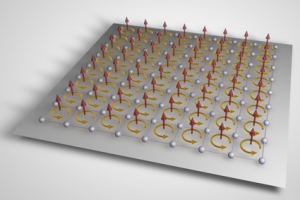Oct 30 2013
After more than 40 years of intense research, experimental physicists still seek to explore the rich behaviour of electrons confined to a two-dimensional crystalline structure exposed to large magnetic fields. Now a team of scientists around Prof. Immanuel Bloch (Chair for Experimental Physics at the Ludwig-Maximilians-Universität Munich and Director at MPQ) in collaboration with the theoretical physicist Dr. Belén Paredes (CSIC/UAM Madrid) developed a new experimental method to simulate these systems using a crystal made of neutral atoms and laser light.
In such artificial quantum matter, the atoms could be exposed to a uniform effective magnetic field several thousand times stronger than in typical condensed matter systems (Phys. Rev. Lett. 111, 185301, 2013).
 Cyclotron orbits of atoms exposed to extremely strong effective magnetic fields in specially engineered light crystals. The effective field strengths realized in the experiment correspond to tens of thousands of Tesla magnetic field strength applied to a real material. In the experiment the celebrated Hofstadter-Harper as well as the Quantum Spin Hall Hamiltonian could thereby be implemented.
Cyclotron orbits of atoms exposed to extremely strong effective magnetic fields in specially engineered light crystals. The effective field strengths realized in the experiment correspond to tens of thousands of Tesla magnetic field strength applied to a real material. In the experiment the celebrated Hofstadter-Harper as well as the Quantum Spin Hall Hamiltonian could thereby be implemented.
Charged particles in a magnetic field experience a force perpendicular to their direction of motion – the Lorentz force –, which makes them move on circular (cyclotron) orbits in a plane perpendicular to the magnetic field. A sufficiently strong magnetic field can thereby dramatically change the properties of a material, giving rise to novel quantum phenomena such as the Quantum Hall effect. The cyclotron orbits shrink with increasing magnetic field. For typical field strengths, their size is much larger than the distance between neighbouring ions in the material, and the role of the crystal is negligible. However, for extremely large magnetic fields the two length scales become comparable and the interplay between the magnetic field and the crystal potential leads to striking new effects. These are manifested for instance in a fractal structure of the energy spectrum, which was first predicted by Douglas Hofstadter in 1976 and is known as the Hofstadter’s butterfly. Many intriguing electronic material properties are related to it, but so far experiments could not explore the full complexity of the problem.
For real materials, entering the Hofstadter regime is typically very challenging because the spacing between neighbouring ions is very small. Therefore inaccessibly large magnetic fields have to be applied. One solution is to synthesize artificial materials with effectively larger lattice constants, such as in two superimposed sheets of graphene and boron-nitride.
The experiments performed by the Munich research team follow an alternative approach. In their experiments large magnetic fields are created artificially by exposing ultracold atoms to specially designed laser fields. The system consists of Rubidium atoms cooled to very low temperatures, which are confined in a period structure formed by standing waves of laser light. “Atoms can only sit in regions of high light intensities and arrange in a 2D structure similar to eggs in an egg carton”, explains Monika Aidelsburger, a physicist in the team of Professor Bloch. “The laser beams play the role of the ion crystal and the atoms the one of the electrons.”
Since the atoms are neutral, however, they do not experience a Lorentz force in the presence of an external magnetic field. The challenge was to develop a technique that mimics the Lorentz force for neutral particles. A combination of tilting the lattice and shaking it simultaneously with an additional pair of crossed laser beams allows the atoms to move in the lattice and perform a cyclotron-like motion similar to charged particles in a magnetic field. In this way, the team succeeded in achieving strong artificial magnetic fields, high enough to access the regime of the Hofstadter butterfly.
In addition, the researchers were able to realize what is known as the Spin Hall Effect, i.e. two particles with opposite spin experience a magnetic field of the same strength but pointing in the opposite direction. As a consequence, the direction of the Lorentz force is opposite for the two spins and therefore the cyclotron-motion is reversed. In their experiments the two spin states were effectively realized by two different states of the Rubidium atoms.
In future experiments the method employed by the researchers could be used to explore the rich physics of the Hofstadter model using the clean and well-controlled environment of ultracold-atoms in optical lattices. Various new experimental techniques such as the quantum gas microscope to detect single atoms could contribute to a deeper understanding of the material properties by directly looking at the microscopic motion of the particles in the lattice. The new method might also open the door for the exploration of novel quantum phases of matter under extreme experimental conditions. [M.A.]
Original publication:
M. Aidelsburger, M. Atala, M. Lohse, J. T. Barreiro, B. Paredes and I. Bloch
Realization of the Hofstadter Hamiltonian with ultracold atoms in optical lattices
Physical Review Letters 111, 185301 (2013)